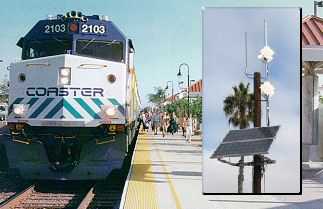Wireless Mesh Train Data, Video & Voice Communications
|
In the news:U.S. public transportation ridership rose 5.2% during the second
quarter of 2008, spurred by higher gasoline prices, the American Public
Transportation Association reported Tuesday.
Riders logged 2.8 billion trips on subways, buses, light rail transit
and regional passenger rail, up from 2.7 billion trips in the second
quarter of 2007. |
The North County Transit District, is using Strix
Wireless Mesh for railway video surveillance, on-board systems
communication and troubleshooting. Considered the first of its kind in
San Diego County,the network utilizes solar-powered wireless network
nodes by Strix Systems which are mounted on poles at a distance of one
mile apart along the edge of the railroad tracks. Additional outdoor
wireless nodes are located and mounted on the train stations. While
trains run at up to 90 miles per hour, network communications including
real-time video surveillance and critical railway communications, is
handed off wirelessly from node-to-node, preserving the throughput and
low latency requirements of these timing sensitive applications.
The San Diego North County Transit District installs cutting-edge wireless computer network. Read the article.
OCEANSIDE ---- Things are meshing nicely along the Coaster rail line from Oceanside to San Diego.
The
North County Transit District, which owns the 42-mile coastal commuter
rail line, is testing its new "mesh" wireless computer network, which
covers about one-quarter of the rail corridor.
The
network, which cost $170,000 and was paid for with a grant from the
U.S. Department of Homeland Security, is designed to help the district
more easily, and cheaply, install video cameras to monitor the railway
and detect intruders, especially near numerous bridges that carry
trains over the region's series of coastal lagoons.
Believed
to be the first of its kind in San Diego County, the network is
composed of 11 solar-powered wireless radios mounted on polls planted a
little less than one mile apart along the edge of the railroad tracks.
Additional wireless base stations are screwed onto the sides of six
train stations. Taken together, the wireless stations ---- called nodes
---- blanket the rail with a wireless signal. Any given node can pass
information on to its neighbor, relaying information through the air to
the district's high-speed fiber-optic network, which is used to carry
video to a central security center.
Kirk
Talbott, chief information officer for the district, said the network
gives the rail line two key abilities that it never had before.
 |
"We
can deploy (security) video cameras anywhere in our right-of-way at a
much lower cost than ever before, because we do not have to dig
trenches and run cables," Talbott said. "We can just put a wireless
camera where we need it, and it will connect to the mesh network." |
Secondly,
the district will now be able to communicate with its trains ---- which
travel as fast as 90 mph ---- as they rush from one station to the
next. In a few weeks, this will allow the district to get real-time
data on a train's performance, relaying everything from speed to oil
pressure back to the main office.
"If a
train breaks down in the field, mechanics will be able to talk to it
and find out what broke so they bring along the right part," Talbott
said.
Discussions are in the works to put
cameras on trains that could relay real-time security video feeds to
the security department.
David Papworth,
director of the district's security department, said Friday that if
cameras were on each train, emergency personnel would be able to use
wireless, hand-held computers to peer inside trains while standing
nearby.
"If something happens, we will be
able to see inside before we go inside, and, from a tactical
standpoint, that can be a big advantage," Papworth said.
At
present, the new network is still being tested. A few wireless cameras
have already been deployed to watch over several key rail bridges, but
the district must still work through several legal issues before
putting cameras on trains.
The mesh
network was installed by Datel Systems, a technology-consulting firm in
San Diego. Bill Bryant of Datel said the network is a first for the
region.
"I believe this is the first
municipal mesh network to be installed in San Diego County," Bryant
said. "We are viewing this as a test case."
The
mesh network, which uses equipment designed by a company called Strix
Systems, is not limited to handling security data. The transit district
has published a request for proposals to install his������ wireless
Internet access on its Coaster commuter trains.
Talbott
said the network, which can transfer data at speeds between 17 and 20
megabytes per second, potentially has enough extra capacity to serve as
part of a wireless Internet backbone. A typical high-speed home
Internet connection generally downloads data at speeds ranging from 1
to 5 megabytes.
He said extending the network to cover the rest of the rail right of way will be relatively easy.
"The
nodes only cost a couple grand each, so we can creep south a little at
a time as the money becomes available," Talbott said. |